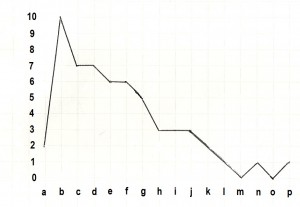Of the fifty-seven sightings of apparent pterosaurs in which wingspan estimates were given (numerically, like “ten feet”), observed around the world and over many years, from the mid-twentieth century to the present, the graph shows longest wingspans to the right (every three feet, beginning with 3.25 feet; the furthest to the right, “p,” is 45.5 to 48.5 feet); the verticle indicating the number of sightings. It appears perfectly harmonious with the idea that at least most modern species experience growth throughout lifespan, with extremely large individuals being rare. The degree of rarity should be much greater than shown, for the largest modern pterosaurs should be noticed by eyewitnesses much more frequently than smaller ones; small pterosaurs can easily be ignored, for they often are not noticed as anything unusual enough to cause eyewitnesses to take a closer look and see that it is no bird.
 The Hoax Potential and Pterosaur Wingspan
The Hoax Potential and Pterosaur Wingspan
The peak, ten sightings, is at wingspan estimates between 3.25 feet and 6.25 feet. On the surface, this appears to clearly refute any possibility of a major hoax-influence, for why would hoaxers give such small “estimates” for the wingspan? Looking a little deeper, if hoaxers were trying to convince people that they had seen Rhamphorhynchoids, smaller wingspans would be more in harmony with fossils of those long-tailed pterosaurs. But looking even closer, we see something else.
Look at the raw data for the left and middle of the graph (wingspan in feet):
2 2 4 4 4 4 5 5 5 6 6 6 7 7 8 8 9 9 9 10 10 10 11 11 12 12 12.5 13 13 13 13 15 16 16 17 17 17 18 — According to standard ideas in paleontology (and that is mostly what is mentioned in Western media when it is mentioned at all), only a small percentage of Rhamphorhynchoids attained wingspans over eight feet. But the data on wingspan estimates does not show any sharp decline above six feet, more of a gentle downward slope (fewer eyewitness estimates) into sizes much larger than standard ideas about Rhamphorhynchoid fossil wingspans. If a significant number of hoaxers made some of these fifty-seven estimates, and a significant number of those hoaxers were trying to portray Rhamphorhynchoids, there would have been a steeper decline above seven feet. But in fact, 26% of reports involved wingspans estimated at 9-13 feet, completely out of line for this particular hoax conjecture.
Another Hoax Potential
Consider the most likely cause for someone to play a hoax. A jokester would likely want to shock somebody. What would be most shocking? Would it not be a huge wingspan? But if hoaxers were involved in this way, the data would not show a rather smooth transition from small wingspans into the giant ones. From a significant hoax factor of this kind, we would expect to see a peak at around 15-25 feet (around f, g, and h, on the above graph); but that is not at all what the data shows.
Pterosaur Wingspan, Recent Statistics, Absence of Hoaxes
But first we review this perspective: A number of species of pterosaurs (more than two) live in many areas of this planet, with at least most of them being at least mostly nocturnal and with some of them being witnessed by people in countries in which universal dinosaur and pterosaur extinction is taken for granted. These species include both Pterodactyloids and Rhamphorhynchoids.
Source of Data
I obtained the 98 reports from years of interviewing and research, accepting data from those reports that had both reasonable non-hoax credibility and reasonable potential for coming from actual sightings of living pterosaurs. In about two-thirds of those reports, I was at least somewhat involved; often I was the only interviewer. One example can be mentioned here:
Philadelphia, Pennsylvania Pterosaur Sighting
“It was several years ago . . . approximately 5:00 A.M. . . . almost sure it was summer . . . in Philly. [My friend] was dropping me off, and parked. . . . . . about six blocks away . . . we saw something that made our jaws drop. We were like ‘what the h* is that thing?’ This thing didn’t seem to fly quickly. [Its] wingspan was huge. We’d figured at least 20 feet or so. It wasn’t flapping real hard like a sparrow or pigeon does. It almost seemed to sail. It came from the South, and appeared to be heading west [towards the Delaware River].” (From the nonfiction cryptozoology book Live Pterosaurs in America – third edition)
Live Pterosaurs and Science [updating the above]
Recent compilations of data support the earlier finding of a lack of major hoax involvement.



4 Replies to “More on Pterosaur Wingspans”
Comments are closed.